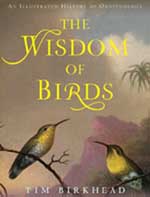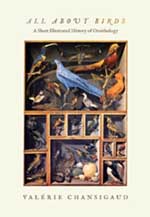
The Wisdom of Birds: An Illustrated History of Ornithology
Tim Birkhead
Bloomsbury USA, 2008

All About Birds: A Short Illustrated History of Ornithology
Valérie Chansigaud
Princeton University Press, 2010
These interesting and attractive books are devoted to the history of the study of birds. The classic work by Stresemann (1975), a scholarly history aimed at a professional audience, has long been out of print. Also, as an English translation of a German book originally published in 1951 it is now six decades old. There have been more recent works, generally of a more specialized nature: Farber (1982) looks at ornithology’s development as a modern science from the late-18th Century to the mid-19th Century while Walters (2003), though aimed at a more general audience than the earlier works, emphasizes classification and taxonomy. Despite its title, Bircham’s (2007) book focuses on the history of British ornithology rather than the field as a whole. For American ornithology see the fine book by Barrow (1998).
Stresemann’s study contains no illustrations (other than a frontispiece photo of the author) while Walters’ has many pictures of scientists and a handful of birds (all in black and white). These latest two boos by Birkhead and Chansigaud, as did the works mentioned above, originated in Europe, but as their subtitles state are heavily illustrated. Beyond that these two new works take very different approaches to their subject.
Chansigaud’s book was originally published in France in 2007, with an English translation in the United Kingdom in 2009 and finally this American edition. It is a relatively slender volume and follows what might be considered a more traditional approach than Birkhead. After a brief introduction, seven chapters chronologically look at ornithology, starting with “Antiquity” followed by “The Middle Ages” and “The Renaissance”, then a chapter each for four centuries from the 17th Century to the 20th Century. From Aristotle to 20th Century ornithologists, the focus is the people who have brought the study of birds from mythology to a modern science. The text is clear and well-written; however the occasional odd phrasing reminds the reader that it was not originally written in English.
The main illustrations are nearly all of birds from illustrated works over the centuries. Except for older monotone works these are all in color. The quality of the reproductions is excellent, if a bit small. Many famous bird artists are represented including Audubon, Fuertes, Gould, Keulemans, Lear, Wilson and others; some of these are themselves discussed in the main text. There is also some lovely work by unknown Indian artists (pp. 111, 115), a legacy of the British Empire. Unfortunately, there are also a few illustrations where the artist is not credited and only the author of the work in which it was published is listed (such as pp. 150, 157, 160). For a dedicated survey of bird art, see the beautiful book by Linnaean members Pasquier and Farrand (1991) or the more recent one by Elphick (2005). Throughout Chansigaud’s book there are smaller, marginal illustrations. A few are the title pages of major publications or the logos of important organizations, but most are pictures of the people discussed in the main text. The captions of the latter usually include information about the person. I noticed one misleading caption. Under the photo of Ernst Mayr (p. 202), one of the 20th Century’s top ornithologists and a long-time Society member, it states he made his career at the American Museum of Natural History. While Mayr first came to the United States to work in New York (1931-1953) and did much important work at the American Museum, he spent most of his long life and career at Harvard’s Museum of Comparative Zoology (1953-2005).
Chansigaud’s book concludes with a few pages on the current role of ornithology and ornithological collections, a brief bibliography, an index of people and institutions and a twenty page timeline from 340 BC to 2002.
Instead of strict chronological order, Birkhead’s organizes his book around the biology of birds. In chapters devoted to different aspects of avian life history he traces the historical discovery and development of knowledge in each subject. There are chapters on embryology, development and instinct, migration, breeding cycles, territory, song, sexual dimorphism, mating systems, longevity and lifetime reproduction. Throughout, material is presented in a well-written, clear, nontechnical style accessible to a general audience. The reader will learn a lot of history, as well as avian biology. One fascinating story concerns the Acorn Woodpecker. Acorn’s are social breeders living in groups – young males from previous seasons assist their parents while females disperse to other groups. Birkhead tells the story of a researcher following a young female as she moved to another group only to be driven off by that group’s males. The female returned to her family and after interactions with her brothers went back to the second group accompanied by her brothers who attacked the males there until she was accepted! Her brothers then returned to their own family group.
As in the previously discussed book, this book is extensively illustrated in color, mostly with plates from old bird books, but here the plates are chosen to illustrate a biological subject being presented, rather than primarily as examples of bird artists. There is an extensive bibliography, a short glossary and a full index.
The central figure in Birkhead’s history, the man he considers “the most influential ornithologist of all time” is 17th Century polymath, cleric and naturalist John Ray (16271705). A recent book on history’s greatest naturalists refers to Ray as the “English Aristotle” (Huxley 2007 – a book I also recommend). The encyclopedia Ornithologia Libre Tres by Francis Willughby, published by Ray in 1676, is often considered the birth of ornithology. (In Chansigaud’s book the subtitle of his 17th Century chapter is “The founding work of John Ray and Francis Willughby”.) Ray was the son of a blacksmith. Willughby, Rays’ junior by eight years, came from the aristocracy. They met as students at Cambridge and in spite their different backgrounds became best friends and coworkers. When Willughby died in 1672 at age 37, Ray became one of his executors and tutor to his children. Until then primarily a botanist, Ray completed the bird book they had been working on, publishing it under his friend’s name. Ornithologia presented the first modern classification of birds, often considered superior to the one proposed by Linnaeus sixty years later (Stresemann 1975). For over 300 years debate has continued, heatedly at times (Raven 1942, Bircham 2007), on who should receive the majority of the credit. One of Ray’s later books, The Wisdom of God Manifested in the Works of the Creation (1691) inspired the title of Birkhead’s book. Following Haffer (2007), Birkhead presents the case that after Ray ornithology followed two parallel, but separate paths. One, with roots in Ornithologia, stressed classification and faunal studies, while the other, stemming from The Wisdom of God, stressed field study. The two branches were reunited into modern avian biology in the 1920’s and 1930’s by Erwin Stresemann and David Lack. In a way Chansigaud’s and Birkhead’s two histories reflect that dichotomy and complement each other very well.
Though the Linnaean Society of New York is not mentioned in either book, papers published in Society publications are mentioned, sometimes prominently. Birkhead’s bibliography includes papers by Ernst Mayr, Margaret Morse Nice and Nikko Tinbergen originally published in the Society’s Proceedings and Transactions. Chansigaud also mentions Nice’s landmark Song Sparrow work and Tinbergen’s Snow Bunting study.
Literature Cited
Barrow, M. V., Jr. 1998. A Passion for Birds: American Ornithology after Audubon. Princeton Univ. Press.
Bircham, P. 2007. History of Ornithology.
Collins. Elphick, J. 2005. Birds: The Art of Ornithology. Rizzoli.
Farber, P. L. 1982. Discovering Birds: The Emergence of Ornithology as a Scientific Discipline, 1760-1850. Johns Hopkins Univ. Press.
Haffer, J. 2007. The Development of Ornithology in Central Europe. Jour. of Ornithology 148 (S125-S153).
Huxley, R. (ed.) 2007. The Great Naturalists. Thames and Hudson.
Pasquier, R. F., and J. Farrand, Jr. 1991. Masterpieces of Bird Art: 700 Years of Ornithological Illustration. Abbeville Press.
Raven, C. 1942. John Ray, Naturalist: His Life and Works. Cambridge Univ. Press.
Stresemann, E. 1975. Ornithology from Aristotle to the Present. Harvard Univ. Press.
Walters, M. 2003. A Concise History of Ornithology. Yale Univ. Press.

